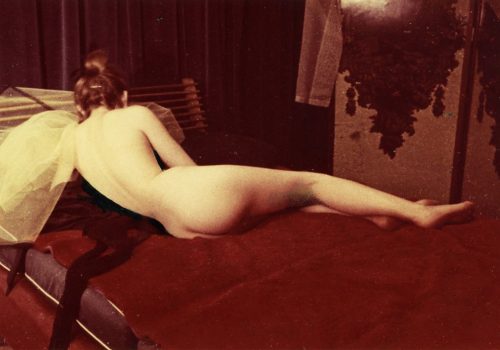With his multifaceted abilities and interests, Carlo Mollino (1905 – 1973) was one of the most famed and eclectic architect of the 20th century. He was a skilled skier, designer and pilot of racing cars and airplanes. And a photographer, too. He was born and used to live in Turin, where CAMERA – Centro Italiano per la Fotografia organised an interesting exhibition .
As Mollino always thought of photography as a favourite medium – he practiced it from 1934 to 1973 –, CAMERA hosts the greatest show so far, focused on the unique relationship between Mollino and photography, from his first shots of architecture to his latest Polaroids.
It’s the 2018 season opening show for the Turinese venue: “CAMERA has been working for a long time on this exhibition, in collaboration with the Politecnico (Polytechnic University) of Turin: all the images on stage (more than 500) come from their archives. Indeed, Mollino represents the many aspects of CAMERA as an author extremely related to Turin and an international phenomenon at the same time. He is a historicized author, but his iconic language has a unique modernity; his huge and fascinating production allows to display both famous works as well as unedited images. They are photos, but they somehow represent a world”, Walter Guadagnini, Camera director says.
Carlo Mollino began photography in the 1930’s, producing a vast collection of pictures that benefited from both the classical tradition and the impetus towards some new contemporary expressive forms. “In the 1930s and’ 40s, when Mollino began his researches and wrote his fundamental book Il Messaggio dalla Camera Oscura, he looked like one of the most informed intellectuals about the international scene. Actually he dealt with photography without any prejudices against an art often thought of as a ‘minor art’ by large parts of the Italian culture of the time”, Guadagnini adds.
The exhibition goes beyond any severe classification by sectors as Carlo Mollino used to carry out very different projects and interests at the same time, letting them flow together. “There are no sections in the show, the images are mixed together, according to a fil-rouge that reminds of Mollino’s organic and eclectic vision in his photos as well as in his design projects with their sinuous and “arborescent” shapes. Organic nature is the link that allows a consistent path for this exhibition: we can find sinuous lines in the trails left by skiers on the snow, in the pattern of streets and rivers seen from an airplane (cf. the contemporary Aeropainting, an expression of Futurism, Ed.), in the lines of the women he portrays. The show flows as images accumulate immediately after each other (evoking the way the Italian poet Gabriele D’Annunzio furnished his house-museum at the Vittoriale, Ed.), in order to favor the idea of a continuous ongoing surprise, breaking chronological or thematic linearity”, the curator of the exhibition, Francesco Zanot, says.
Actually “accumulation” was an attitude influenced by the 19th century trend of collecting, though Mollino connected it to a strong inclination to research: Two tensions that converged into unexpected results.
The exhibition includes four areas, entitled with quotations from the author’s writings. Visitors are welcomed by Mille case, on interior and architectural photos, besides a series of snapshots taken on his travels. Then one enters Fantasie di un quotidiano impossibile focused on the surrealist atmospheres with images on different subjects aimed at questioning the reality as captured and represented by the camera (i.e. shops with their windows displays echoing Eugène Atget, photomontages in collaboration with Riccardo Moncalvo, images from Occhio magico, 1945). Mistica dell’acrobazia is devoted to his love for speed, aeronautics and racing cars (including the Bisiluro he designed together with Mario Damonte and Enrico Nardi). L’amante del duca displays more than 180 photos dealing with body and posing issues. On the one hand his skiers and on the other his portraits, his well-known Polaroids and many vintage prints, where one can feel a firm reference to classicism (i.e. the reinterpretation of The Rokeby Venus by Velàzquez) as well as the innovative framing of many of his images.
Almost all the materials on display come from the collections of the Politecnico of Turin, Archivi Biblioteca Centrale di Architettura Roberto Gabetti, Fondo Carlo Mollino, According to Sergio Pace of the Politecnico– DAD (Architecture and Design Department), “Mollino has been paying extraordinary attention to photography throughout his whole career, leaving evidence of both his own design activity and his vast interests, that made him one of the most fascinating artistic spirit of his time”. The archive preserves thousands of his photos, often retouched by hand. It’s a valuable fund in order to further explore Mollino’s work as well as an important chapter in the history of photography, in Italy, during the first decades of the 20th century.
Paola Sammartano
Paola Sammartano is a journalist specialized in arts and photography based in Milan, Italy.
L’occhio magico di Carlo Mollino – Fotografie 1934-1973
January 18 to May 13, 2018
CAMERA – Centro Italiano per la Fotografia
Via delle Rosine 18
10123 Torino
Italy
http://camera.to/
Catalogue: essays by Francesco Zanot, Enrica Bodrato, Fulvio Ferrari and Paul Kooiker (Silvana Editoriale publisher)
















